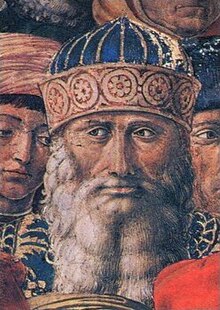Neopaganism is generally a new movement, grown from the weakening of the Church's power in temporal matters during the Enlightment. But, what if I was to tell you that there were Neopagans in Europe during dangerous times to be even non-Catholic or non-Orthodox, Neopagans whom not old believed in and worshiped the Old Gods, but also was an advocate of Polytheism and even possibly built a Temple in their honor? There was such a brave man, who faced the odds, reintroduced Plato's writings and Hermetic texts to Europe, attempted to fix the Great Schism between the Catholic and Orthodox Churches, and called people back to the worship of the Gods of Greece and Rome. His name, was Gemistus Pletho
Pletho, originally called Georgius Gemistus, was born around 1355, and was an avid student of philosophy in the Byzantine Empire. He studied in Adrianopolis during the time of its take-over by Sultan Murad I when he was just ten years old. He took his name of Plethon from Plato himself, since he was inspired by his works. Many considered the man to be the second Plato. I'm sure we might think of him as a possible reincarnation of Plato. Cardinal Bessarion certainly thought so, and he was Catholic.
Pletho was confined in Mistra by the Emperor of the Byzantine Empire for heresy against the Church, but developed such a following that the penultimate emperor, John VIII, consulted him on the unification of both the Catholic and Orthodox churches. During this time, he began a philosophical debate that burns even to this day: who's teachings should we follow more: Aristotle or Plato? He also influenced the likes of Cosimo de'Medici and Marsilio Ficino, and is ultimately the father of the Renaissance.
I worshiped the Old Gods before it was cool.
What makes this Renaissance man a Pagan, besides the accusations? Pletho wrote two books that unfortunately no longer exist but in fragments thanks to Patriarch Gennadius II, the Summary and the Nomoi. In both, Pletho called for a return to the worship of the Olympians and to the use of Neoplatonic Theurgy. This worship also called on the person to use logic and reason instead of faith. Humans are related to the Gods, and thus should strive to Virtue and Goodness to be like the Gods, doing so over many lifetimes through reincarnation. The Universe was neither created nor could it be destroyed, and was perfect and not fallen or evil. The three greates of the Gods were Zeus, Poseidon, and Hera, who ruled over the World. While there were section detailing his thoughts on society and government, the meat of it was an advocacy for Neopaganism.
Pletho would return to Mistra and begin a Mystery School in which he instructed his students into proper worship of the Gods. Pletho died around 1452, almost living to be 100 years old. In 1464 his remains were moved to the Tempio Malatestiano in Rimini, Italy. This church, dedicated to St, Francis of Assisi, was considered to be an exaltation of paganism, and Pope Pius II said it was, "full of pagan gods and profane things." The people who moved Pletho's body wanted him to be buried among free men.
The Tempio Malatestiano



No comments:
Post a Comment